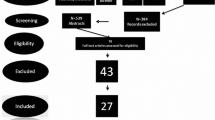Abstract
Background
To compare clinical effect and safety between posterior fossa decompression with duraplasty (PFDD) and posterior fossa decompression without duraplasty (PFD) in treatment of Chiari type I malformation and basilar impression.
Methods
A comprehensive computer search was conducted from 2000 to 2019. The quality assessment was performed by the QUADAS-2 tool. The clinical value of comparison between PFDD and PFD was evaluated by using the pooled estimate of sensitivity and specificity. In addition, sensitivity analysis and bias analysis were applied to ensure the accuracy of the results.
Results
Finally, 468 patients were enrolled in 6 studies and ultimately met the eligibility criteria. The PFDD and PFD groups were 282 and 186, respectively. The meta-analysis showed no significant difference in the Chicago Chiari Outcome Scale (COSS score) (MD = 0.14, 95% CI [−0.23, 0.50], P = 0.47; P = heterogeneity = 0.86, I2 = 0%). Meanwhile, Significant difference existed in length of stay (MD = −1.08, 95% CI [−1.32, −0.84], P = 0.001; heterogeneity P < 0.000001, I2 = 85%) and complications (OR = 0.35, 95%CI [0.20, 0.62], P = 0.0003; P for Heterogeneity = 0.04, I2 = 56%).
Conclusion
PFD is a more efficient and safer therapy than PFDD in the treatment of Chiari type I malformation with basilar impression.








Similar content being viewed by others
References
Chen J et al (2017) Comparison of posterior fossa decompression with and without duraplasty for the surgical treatment of chiari malformation type I in adult patients. Medicine 96(4):e5945
Deng X et al (2013) Surgical treatment of chiari I malformation with ventricular dilation. Neurol Med Chir 53(12):847–852
De Vlieger J, Dejaegher J, Van Calenbergh F (2019) Posterior fossa decompression for chiari malformation type I: clinical and radiological presentation, outcome and complications in a retrospective series of 105 procedures. Acta Neurol Belg 119:245–252
Munshi I et al (2000) Effects of posterior fossa decompression with and without duraplasty on chiari malformation-associated hydromyelia. Neurosurgery 46(6):1384–1390
Shweikeh F et al (2015) National trends, complications, and hospital charges in pediatric patients with chiari malformation type I treated with posterior fossa decompression with and without duraplasty. Pediatr Neurosurg 50(1):31–37
Chotai S, Medhkour A (2014) Surgical outcomes after posterior fossa decompression with and without duraplasty in chiari malformation-I. Clin Neurol Neurosurg 125:182–188
Kennedy BC et al (2015) Outcomes after suboccipital decompression without dural opening in children with chiari malformation type I. J Neurosurg Pediatr 16(2):150–158
Milhorat TH et al (1999) Chiari I malformation redefined: clinical and radiographic findings for 364 symptomatic patients. Neurosurgery 44(5):1005–1017
Teo KA et al (2018) Minimally-invasive approach to posterior fossa decompression: initial experience in adult chiari type 1 malformation patients. J Clin Neurosci 56:90–94
Shamji MF et al (2010) Classification of symptomatic chiari I malformation to guide surgical strategy. Can J Neurol Sci 37(04):482–487
Sha S et al (2014) Brace treatment versus observation alone for scoliosis associated with chiari I malformation following posterior fossa decompression: a cohort study of 54 patients. Eur Spine J 23(6):1224–1231
Mutchnick IS et al (2010) Decompression of chiari malformation with and without duraplasty: morbidity versus recurrence. J Neurosurg Pediatr 5(5):474
Lee A et al (2014) Comparison of posterior fossa decompression with or without duraplasty in children with type I chiari malformation. Child’s Nerv Syst 30(8):1419–1424
Jiang E et al (2018) Comparison of clinical and radiographic outcomes for posterior fossa decompression with and without duraplasty for treatment of pediatric chiari I malformation: a prospective study. World Neurosurg 110:e465–e472
Kumar A et al (2019) Response of syrinx associated with chiari I malformation to posterior fossa decompression with or without duraplasty and correlation with functional outcome: a prospective study of 22 patients. J Neurosci Rural Pract 09(04):587–592
Yilmaz A et al (2017) Adding expansile duraplasty to posterior fossa decompression may restore cervical range of motion in grade 3 chiari malformation type 1 patients. World Neurosurg 98:98–103
Lu VM et al (2017) The addition of duraplasty to posterior fossa decompression in the surgical treatment of pediatric chiari malformation type I: a systematic review and meta-analysis of surgical and performance outcomes. J Neurosurg: Pediatr 20(5):439–449
Bindal AK, Dunsker SB, Tew JM (1995) Chiari I malformation: classification and management. Neurosurgery 37(6):1069–1074
Schijman E, Paul S (2004) International survey on the management of chiari I malformation and syringomyelia. Childs Nerv Syst 20(5):341–348
Caffo M et al (2019) Minimally invasive posterior fossa decompression with duraplasty in chiari malformation type I with and without syringomyelia. Surg Neurol Int 10:88
Carr CW et al (2010) Chiari I malformation, delayed gross motor skills, severe speech delay, and epileptiform discharges in a child with FOXP1 haploinsufficiency. Eur J Hum Genet: EJHG 18(11):1216–1220
Strickland A et al (2018) Divergence insufficiency alleviated by posterior fossa decompression with duraplasty in a patient with chiari type 1.5 malformation. J Neurosurg: Pediatr 22(5):504–507
Batzdorf U (1988) Chiari I malformation with syringomyelia. evaluation of surgical therapy by magnetic resonance imaging. J Neurosurg 68(5):726–730
Nikoobakht M et al (2019) Craniometrical imaging and clinical findings of adult chiari malformation type 1 before and after posterior fossa decompression surgery with duraplasty. Br J Neurosurg 33(5):481–485
Funding
None.
Author information
Authors and Affiliations
Corresponding author
Ethics declarations
Conflict of interest
We declare no financial or other relationship causing conflict of interest in this study.
Additional information
Publisher's Note
Springer Nature remains neutral with regard to jurisdictional claims in published maps and institutional affiliations.
Rights and permissions
About this article
Cite this article
Cai, S., Tian, Y., Zhang, J. et al. Posterior fossa decompression with or without duraplasty for patients with chiari type I malformation and basilar impression: a meta-analysis. Eur Spine J 30, 454–460 (2021). https://doi.org/10.1007/s00586-020-06643-w
Received:
Revised:
Accepted:
Published:
Issue Date:
DOI: https://doi.org/10.1007/s00586-020-06643-w




